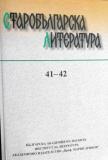Отново за означените като „български“ песнопения в музикални ръкописи
The Chants Designated as “Bulgarian” in Musical
Manuscripts Once Again
Author(s): Svetlana KujumdzievaSubject(s): Cultural history
Published by: Институт за литература - БАН
Summary/Abstract: THE CHANTS DESIGNATED AS “BULGARIAN” IN MUSICAL MANUSCRIPTS ONCE AGAIN SVETLANA KUJUMDZIEVA (SOFIA) (S ummery) M. Velimirović was the first to announce about some chants designated as “Bulgarian” in medieval musical manuscripts. His work was continued by Kr. Stanchev and E. Toncheva. “Bulgarian” chants are of various genres, all of which are for festal occasions: polyeleoi, kratemata, and communion. In the present contribution one more genre (cheroubikon or offertory) and two more copies of the most popular polyelos are added to the known until now “Bulgarian” chants. The latter constitute a stable repertory in the book of the Akolouthiai-Anthologies compiled according to the revised liturgical ordo of Jerusalem. Almost all of them are linked with the names of people close to the great medieval musician John Koukouzeles: John Glykys (Koukouzeles’ teacher), John Kladas (Koukouzeles’ school-fellow), Dimitry Dokeianos (Koukouzeles’ pupil), Koukouzeles himself. Two of „Bulgarian” designations deserve special attention. One of them is “ἡ βουλγάρα” which means “Bulgarian woman”. There are different interpretations of this designation. One of them is that such chants were devoted to Koukouzeles’ mother; another is that they are evidence of the increased attention to women in the 14th century. The other designation is unique. Its rubrics read: “…by Dokeianos in the first mode, imitating a Bulgarian lamentation tune”. All the “Bulgarian” chants go beyond a local significance: in all probability they were designed to foster the unity of the Christian Faith. They could be considered as “ambassadors” for the beauty of the Eastern Orthodox culture and also, as proof of an “open” culture between East and West during the Middle Ages about which our knowledge is still rather rudimentary.
Journal: Старобългарска литература
- Issue Year: 2009
- Issue No: 41-42
- Page Range: 441-453
- Page Count: 12
- Language: Bulgarian
- Content File-PDF

